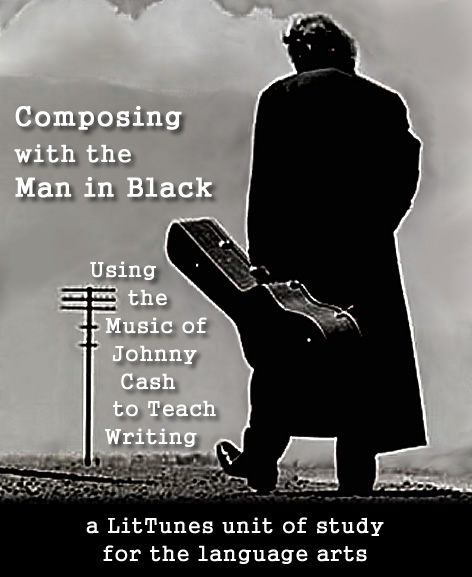|


Teaching
the Writing
Techniques
of Voice, Style,
and Self-Reflection
with the Tunes of Johnny Cash
Description of Presentation:
Drawing upon a variety of materials about Johnny Cash, including Joaquin Phoenix’s recent film, Walk the Line, this presentation will demonstrate how to teach a variety of writing techniques, such as voice, style, and self-reflection. This presentation is suitable for secondary language arts teachers or college composition instructors.
Introduction:
Composing with the Man in Black first took form during a Composition II course at Allen County Community College in July 2006. It was conceived through the desire to model the composition process in real-life situations. The unit proved successful and is now taught in my English classes at Ottawa High School.
This unit reflects my movement towards a constructivist philosophy of education. Rather than teaching the basic skills or Locke’s atoms, I encourage students to make mental connections about reading, writing, and the world around them. While making such connections is difficult to do in the four short weeks of a summer course, by drawing upon the students’ schema, I can connect the new learning to their background.
In Composing with the Man in Black, I use media — movies and music — to demonstrate writing techniques. In my high school classes, utilizing prior knowledge is very helpful when working with reluctant students because it lowers their resistance to learning. Students are more wiling to participate if they feel confident in their subject matter.
Composing with the Man in Black is also Dewey-like in that it provides opportunities for students to draw upon their own interests as they write. It also fits Dewey’s philosophy because it incorporates group interaction. Students first think about what makes a “good” song, and then find their favorite song and share it with their peers. In this process, the class can talk about composing and evaluation without having to leave the zone of proximal development as outlined by Vygotsky.
Student Objectives:
Students will:
 Become acquainted with Johnny Cash
Become acquainted with Johnny Cash
 Compare and contrast differences between his musical style and an imitator’s
Compare and contrast differences between his musical style and an imitator’s
 Write compositions with an awareness of the value of voice in writing
Write compositions with an awareness of the value of voice in writing
Resources:
 Fox DVD: Walk the Line (2005)
Fox DVD: Walk the Line (2005)
 Wind-Up CD: Walk the Line (2005)
Wind-Up CD: Walk the Line (2005)
 Legacy Recordings CD: The Legend of Johnny Cash (2005)
Legacy Recordings CD: The Legend of Johnny Cash (2005)
Preparation:
1. Review the available Johnny Cash material.
2. Make arrangements to share the audio and video segments with students (e.g., making copies of the text version or using a multimedia projector, setting up computer access to play the audio version, arranging for television or projectors for the video version).
Instruction and Activities:
The four lessons and follow-up activities that comprise Composing with the Man in Black may be presented as stand-alone exercises. They also provide an integrated thematic unit to anchor ongoing writing lessons over a semester or an academic year.
Overview:
The goal of "One Song That Would Sum You Up" is to get students to see someone write and
then get feedback from an audience.
1. From the DVD, view Cash’s writing of “Folsom Prison Blues,” ending at his
meeting with Sam Phillips.
2. Have students discuss the segment. Here are some questions to guide your discussion.
A. How did Cash come to write the song?
B. What did he mean by not liking the Air Force?
C. For Cash, how was the Air Force like prison?
D. What did Sam Phillips mean by that one song?
3. Following Sam’s directive, have students bring in a song that they would consider their most influential.
4. Have students write why they feel the song is important to them.
5. During the next class session, have students play song selections and discuss why the songs are important to them.
6. Have students write that one piece of literature that they would like to take with them. The genre does not have to be a song; it could be a student choice.
Follow-Up Activity:
Lennon’s Lyrics
By listening to variations of John Lennon’s song, “Strawberry Fields Forever,”
students will be able to see how a composition goes through various stages.
This activity works especially well with portfolios as at the end of the lesson, the student can apply the knowledge to their own drafts found in their portfolios.
Resources: The Beatles Anthology, Volume 2 Disk 2
Instruction and Activities:
1. Discuss/review with students the composition process, emphasizing how writing can evolve from draft to draft.
2. Play track 2, “Demo Sequence.”
3. Discuss with students their perceptions:
— Is the song good/bad?
— Is the song finished?
— What is the song missing?
4. Play track 3, “Take 1.” Have students note variations:
— Tempo
— Instrumentation
— Other changes
5. Play track 4, “Take 7 and edit piece.” On the board or individually, have students map out variations in the three pieces.
Overview:
By close inspection of Cash’s material, we can look at how the songs serve as a metaphor for his life.
Materials Needed: Handouts of “Folsom Prison Blues.”
1. Give students the handout of the song.
2. Replay “Folsom Prison Blues.”
3. Have students look at the song as a metaphor
for Cash’s life.
4. Have students create a metaphor for their own life.
Overview:
By comparing and contrasting song tracks, students can hear differences in voice. They can see how voice affects compositions.
1. Select a song for study. Good choices might be “Ring of Fire” as the background music differs, or “Folsom Prison Blues” as they have seen it performed from Lesson One.
2. Have students read a copy of Cash’s lyrics without any background music. You could also project on the board.
3. Play one of Joaquin’s interpretations.
4. Have students note the composition of the song:
A. Type of Song
B. Tempo
C. Tone
D. Musical instruments
E. Describe his voice
5. Then play Johnny’s version. Have students note differences from above list. Some of the things you might note to the students are how Cash’s voice seems unforced. Joaquin has to strain his voice to get it to sound like Cash. You can also talk about confidence and tone. Since Cash has more confidence, he can be more jovial and even laugh during some of the songs. This conversation can lead you into a discussion of style.
6. Have them write a composition that has a strong voice.
Follow-Up Activity:
Connection to Will Hobbs’ Downriver
Overview: Using the “Understanding Voice” to build background, students can create a short story based upon the novel Downriver.
1. Go to Hobbs’ website where he discusses using Jessie as the narrator for the book.
2. Have students write their own chapters using a different character as the narrator.
A. The chapter can occur during the story, or
B. The chapter can occur after the story.
3. Length
4. Plot diagram: beginning, middle, end.
5. True to story and characters.
Overview:
The goal of this lesson is to get students to see someone write and then get feedback from an audience.
From the DVD, view the segment where Cash watches the boys shining shoes.
1. Have students discuss the segment. Questions to consider:
A. What does Johnny observe?
B. How can he make this observation into a song?
2. Play “Get Rhythm” (Cash’s version is best) to show how he made a song of that one moment.
3. Have students brainstorm things in their lives that might make good writing topics. You might encourage them to keep a journal of ideas.
4. During the next class session, have students play song selections and discuss why the songs are important to them.
5. Have students write something based upon a life experience. The genre does not have to be a song; it could be a student choice.
Extensions:
 Contact a famous musician/writer.
Contact a famous musician/writer.
 Write a review of a new CD.
Write a review of a new CD.
Web Resources:
 Walk the Line
Walk the Line
 The Legend of Johnny Cash
The Legend of Johnny Cash
William C. Sewell 11/19/08
Printer Friendly Lesson Plan:
CLICK the SUN logo below for a printer friendly version of Composing with the Man in Black.
Printer Friendly Lyrics:
CLICK the Stax Records logo below for a printer friendly version of the lyrics to three Johnny Cash songs: "Folsom Prison Blues," "Ring Of Fire," and "Get Rhythm."
E D I T O R ' S N O T E :
William C. Sewell is a doctoral candidate in Curriculum and Instruction with emphasis in English Education at the University of Kansas. Will also teaches English, Debate, and Science Fiction at Ottawa High School. Will’s hobbies include biking with the family, reading science fiction, and writing. Will and his wife, Christina, an English instructor at Allen Community College, live in Garnett with their three children Alex, Katie, and Charlotte. To contact Will, please e-mail him at wsewell@ku.edu
LitTunes was launched on November 12, 2007.
We invite you to come back often as LitTunes
grows and develops.

LitTunes is a part of the CornDancer family of developmental websites.
CornDancer has participated in the World Wide Web since the summer of 2000.
Submissions are invited.
Contact webmaster at threadspinner@corndancer.com
|
|










